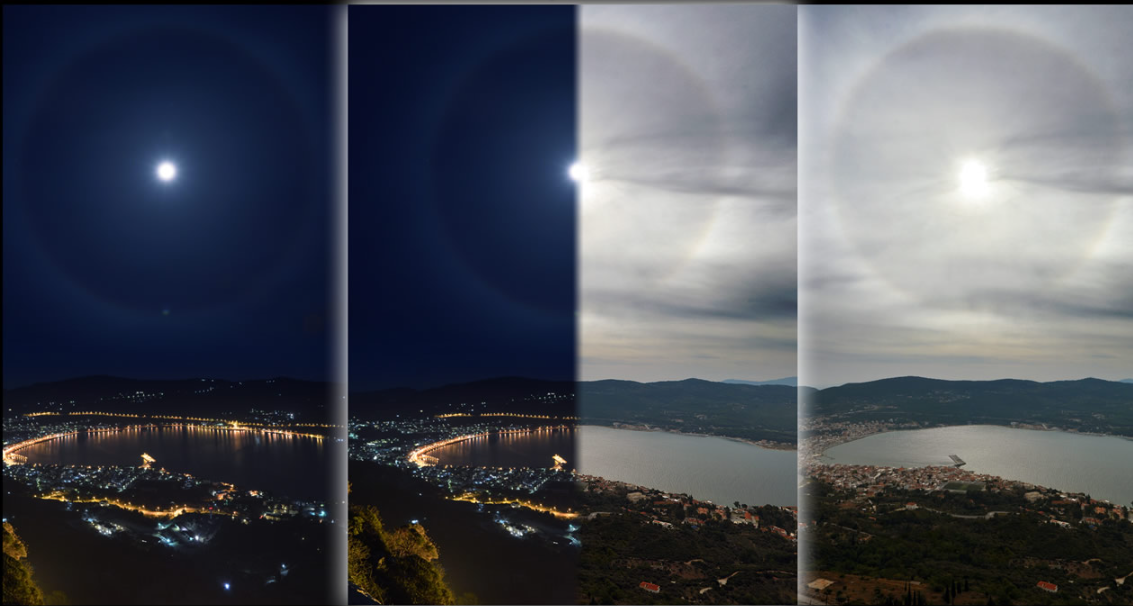Sun & Moon Halos, Samos, Greece - OPOD
Sun & Moon Halos: A Stunning Phenomenon in Samos, Greece
Samos, a picturesque Greek island, is known for its breathtaking landscapes and stunning natural wonders. Among the many captivating sights that grace the island's skies are the enchanting sun and moon halos. These ethereal displays of light have fascinated observers for centuries, evoking a sense of wonder and curiosity. In this article, we will delve into the mesmerizing world of sun and moon halos, exploring their origins, characteristics, and the unique spectacle they create in Samos, Greece.
Identically Sized Ice Halos: A Proof of Nature's Symmetry
One remarkable aspect of sun and moon halos is that they both create identically sized ice halos. This intriguing phenomenon occurs when the light from these celestial bodies passes through ice crystals suspended in the atmosphere. The ice crystals act as tiny prisms, bending and refracting the light, resulting in a circular halo formation around the sun or moon. The reason for the identical size of these halos lies in the parallel nature of the light rays emitted by these distant celestial sources.
Distinguishing Halos from Nearby Lights
It is important to note that while sun and moon halos exhibit this symmetrical characteristic, halos created by nearby lights behave differently. When the light source is in close proximity, such as a streetlamp or a porch light, the angle at which the light rays reach the ice crystals varies, leading to variations in the size and shape of the halo. This contrast between distant and nearby light sources adds to the allure and uniqueness of sun and moon halos.
The Delicate Dance of Ice Crystals
To fully appreciate the intricate beauty of sun and moon halos, one must understand the role of ice crystals in their formation. These ice crystals can take on various shapes, including hexagonal plates, columns, and needles. As the light passes through these crystals, it undergoes a process called refraction, where it bends and changes direction. This bending of light creates the mesmerizing halo effect that captivates onlookers.
The 22° Halo: A Common Sight
One of the most frequently observed halos is the 22° halo, named after its approximate radius in degrees. This halo forms a circular ring around the sun or moon, appearing at a distance of approximately 22 degrees from the celestial body. The 22° halo is caused by the refraction and reflection of light within the ice crystals. It is often accompanied by other optical phenomena, such as sundogs, which are bright spots of light on either side of the halo.
Sun and Moon Halos in Samos, Greece
Samos, with its pristine skies and idyllic landscapes, provides an ideal setting for witnessing the magical dance of sun and moon halos. As the sunlight or moonlight filters through the island's atmosphere, it encounters the abundant ice crystals suspended in the air, creating a canvas for these enchanting optical phenomena. The combination of the azure Aegean Sea, verdant hills, and the ethereal glow of sun and moon halos make for an awe-inspiring spectacle.
Captivating Images from Samos
Photographer Manolis Thravalos has captured the splendor of sun and moon halos in Samos through his stunning images. His photographs showcase the delicate interplay between light, ice crystals, and the natural beauty of the island. The images reveal the intricate details of the halos, highlighting their symmetrical nature and the captivating colors that emerge as sunlight or moonlight passes through the ice crystals.
Exploring the Mysteries of Atmospheric Optics
Sun and moon halos are just a glimpse into the fascinating world of atmospheric optics. This branch of science delves into the behavior of light in the Earth's atmosphere, unraveling the secrets behind various optical phenomena. From rainbows to mirages, atmospheric optics offers a wealth of intriguing and visually stunning phenomena waiting to be explored and understood.
Embracing the Wonder of Nature
The sun and moon halos that grace the skies of Samos, Greece, serve as a reminder of the beauty and intricacy of the natural world. These ethereal displays of light inspire awe and curiosity, inviting us to marvel at the wonders that surround us. Whether we seek to capture their magic through photography or simply gaze up at the sky in wonder, sun and moon halos remind us of the enchanting mysteries that await our discovery. So next time you find yourself on the captivating island of Samos, be sure to look up and witness the mesmerizing dance of sun and moon halos.

Lunar & Solar 22° Halos Combined ~ Images taken on the Greek island of Samos by Manolis Thravalos (more images). Proof, if proof be needed, that the sun and moon create identically sized ice halos. This is only true for light sources so distant that their light rays are effectively parallel. Halos from nearby lights behave differently.
Images ©Manolis Thravalos, shown with permission
Note: this article has been automatically converted from the old site and may not appear as intended. You can find the original article here.
Reference Atmospheric Optics
If you use any of the definitions, information, or data presented on Atmospheric Optics, please copy the link or reference below to properly credit us as the reference source. Thank you!
-
<a href="https://atoptics.co.uk/blog/sun-moon-halos-samos-greece-opod/">Sun & Moon Halos, Samos, Greece - OPOD</a>
-
"Sun & Moon Halos, Samos, Greece - OPOD". Atmospheric Optics. Accessed on November 15, 2024. https://atoptics.co.uk/blog/sun-moon-halos-samos-greece-opod/.
-
"Sun & Moon Halos, Samos, Greece - OPOD". Atmospheric Optics, https://atoptics.co.uk/blog/sun-moon-halos-samos-greece-opod/. Accessed 15 November, 2024
-
Sun & Moon Halos, Samos, Greece - OPOD. Atmospheric Optics. Retrieved from https://atoptics.co.uk/blog/sun-moon-halos-samos-greece-opod/.